In our full participation, each of us holds the power to elevate any moment from the mundane to the illumined. Presence mixed into routine chore creates an alchemy able to transform all in its midst. Take the simple act of making butter on our farm. I have done tutorials on Instagram, answered questions for burgeoning butter makers, shown picture demonstrations, but none of that’s right. None of what I’ve shared holds the heart of the matter. That’s too long a story when what is wanted is instructions, but it’s the right story. The honest story. The real story.
Why make butter every second day all spring, summer, and autumn long just so we can store enough for a year? Why go through the expenditure of time, energy, cost, frustration, and mess? We could buy organic butter cheaper, but we could not buy our butter. Just like we cannot buy the meat and fats and bones and turnips and raspberries and broth and apples and everything else that is grown here.
What is grown here holds the “terroir”, the taste and essence of place. What is grown here is us, stitched in, and stitched of, the same. The wild plants that came to be here all on their own, need us not, but they feed us still. The soil coats my sweaty skin and is absorbed into my body to become part of me. The cow’s hooves dent the skin of our mother earth, just enough to create micro galaxies, worlds in a hoof print. For every space, uncountable creatures multiply.
I could write love letters to it all. Maybe one day I will have. For now, butter. Butter because I cannot think of anything more lovely to start with. To make the most wondrously delicious butter, we must have the most wondrously, delicious cream. To have that kind of cream, we need to have a cow that is treated well, a cow that is, dare I say it, happy. And to have a cow that is content she must live as a cow should live.
So we’ll start there, with the cow. A magnificent beast worthy of our adoration.
Part One: The Cow
We are here not to mimic the limitations of corporations that must cut corners and bow to the holy god of bottom lines. We are here as smallholders, bearing witness to the radiant. We can do things differently on our small farm because we are beholden only to the rightness of practice, not function and production. So, our cow looks different. Our cow, the cow we will be following along in today’s milking story, is a real cow. Her name is Ursula and she is a cross between a Brown Swiss and a Jersey. She came to be after our youngest daughter became entranced with the stories of Heidi in her Alpine paradise and begged us to breed our beloved Jersey, Bea, to a Brown Swiss sire. Ursula may just be the most beautiful cow I’ve ever known. She is slate grey with a black nose and perfect horns tipped in black. Horns that grew from little buds into the perfect antennae to receive the wisdom of all the cows in all the cosmos. She is gentle and sweet and ever-patient. Ursula is here because of the wishes of a little girl who proudly, and endlessly, reminded us of her role in making the most perfect cow in all the land come to live here, on our little farm.
It is a few minutes after 0500hrs in the morning. Ursula has surfaced from her evening in the forest with her herd. All night they traipsed through the woods until, like the whitetail deer, they bedded down near one another under the stars, chewing their cud in rhythmic meditation. If there are young ones with them, they stay near their mothers. There are predators in the forest, black bears, coyotes, fox, fishers and the like. A few old-timers here have reported that the wolves are returning. It’s possible, but we haven’t seen any. It’s the coyotes that are the biggest threat although a full grown bovine is beyond even their bravado.
Ursula is mooing now, her guttural bellow in competition with the rooster’s alarm. She’s standing at the farm gate behind our house, a place the cattle do not usually pay attention to. There’s nothing on the other side of that gate but our house. But for Ursula, this is exactly the place she needs to be. She knows that the humans are in their human barn and she knows that it’s the humans that open the door to the milking parlour. She demands our presence. Her herd, still in the forest, hear her calls, and realizing she’s left, they all start sauntering up to the farmyard to collect themselves back into a whole. The first of them standing by her, before moving on to the water trough. Ursula is steadfast in her demands. She wants us now!
If you listen close you will hear the faint, squeaky moo of a tiny beast coming from the barn. Ursula’s calf is anticipating the rich, sweet elixir of life - her mama’s milk. In the evening, before the cows headed out into the deep, dark wood, we separated the calf and Ursula after a day of them roaming about in the fields together. The calf will nurse from her mama all day long, whenever she wants to. Ursula will show her whatever needs to be shown, teach her whatever needs to be taught. Ursula will deliver her fury to any brazen young steer who sees this wobbly little calf as an easy target to express their dominance. She will groom her calf, bring her to the shade when it’s too hot to stand under the sun any longer, and stand below the canopy of the trees when the rain pours down on them. And when the calf is too tired to keep up, Ursula will hide her in the woods for a nap. Ursula, who was been born here, cared for and treated well by her mother and the humans around her, will teach her calf how to mother and she will show her calf that we two legged beasts are okay. When we scratch sweet Ursula, handle her, move amongst her and her herd, and she is calm and accepting of us, she is telling her calf, who one day we will be miking, that we’re alright, we can be trusted. Funny looking, to be sure, but okay still.
But they’re both bawling now and we must go outside. Our stainless steel milk pails are clean and sitting by the back door. We fill up another pail with warm water to wash Ursula’s udder. One never knows what will have collected on or around an udder. It all depends on where she slept that night. It might seem a bizarre thought to those unacquainted with milking a cow, but the udder of our extraordinary cow that makes the extraordinary milk must also be considered. There was a time that this was not so, but modernization of milking with robots and machines has seen the selective breeding of cows to have smaller teats in desired placements on the udder. Teats meant for machines. A good set of hand-milking teats is in opposition to the “modern” preferences. I call those little machine teats, “belly button teats”. Imagine fitting the giant paws of a man around little teats to milk them. It is painful and frustrating and wholly unpleasant. But this isn’t that cow. Ursula’s teats are not too long, not too short, they are perfect for calf mouth and human hand alike.
Beyond the teats is the udder itself. Ursula, well exercised and nourished with strong genetics exemplifies the robust health and infrastructure that maintains the strength of the ligaments that hold her udder high and tight. She will not succumb to the loss of something so basic as her suspensory ligament which marks the end of so many dairy cow’s lives.
Like her udder the rest of Ursula is sound. She is what every old fashioned milk cow, a cow meant for a small farm, should be. Her beautiful, ebony hooves do not overgrow and cause her mobility issues. Her back is straight and powerful. Her legs do not bow and her hips are wide enough for her calves to pass through. She does not get ill. She does not suffer from the common, chronic issues of today’s cattle like ringworm, cow lice, and parasites. In fact, I have never seen her sick. When her calves are born, she does not suffer from “milk fever”, a dangerous drop in calcium common in dairy cows that can easily kill them. Her biochemistry and genetics mimic that of her mother. She produces the most sumptuous, high butterfat milk by eating from pasture alone. Not a drop of grain required.
I would be remiss if I didn’t pause here and tell you, also, of Ursula’s start in life because we are, after all, talking about what it takes to make the most decadent of all decadent foods. Unlike many modern dairy cows, Ursula was raised on the colostrum, then the milk, of her own mother. This, to us, is important beyond measure. Not only did her mother show Ursula ‘the way of the cow’, as I wrote about earlier, but her mother nourished Ursula with the nutrients her mother’s body was fed with from the grasses and legumes and diverse and abundant wild plants and leaves and herbs that she ate from this land. All of it transformed, absorbed, and alchemized into life-giving milk for Ursula. It is common today for calves to be fed calf formula. Those are the calfs that will often then go on to be milked. What do we lose there? Longevity, for one. Then, of course, there are all of the ramifications on health to follow including: depressed immune systems, decreases in physical vitality, underperforming gut health, and possible issues with development and fertility. If we are to be increasing the vibrancy of our animals, and that is always our leading principle, we must follow nature’s intelligence.
I wonder if Ursula would meet the standards of a conventional farm. Would she produce the volume that they require? Obviously the milk wouldn’t be shared with a calf and she would receive grain which dramatically increases milk production. I would think she could be ramped up to fall into the acceptable category. But we don’t look for the huge producers. In fact, they spell trouble for us. We want the low producing cow because the lower producing cows require less energy and less energy means they can often thrive on pasture alone. You cannot make any cow a solely grass fed cow unless you have a bit of a mean streak in you. A good farmer puts the land and the animals above goals. A good farmer observes. If your animals are in poor condition because you have drawn hard lines in the sand around the best way to feed them or raise them, you’re missing the plot. Ever seen a skinny pig? I’ve seen a skinny pig and it’s a miserable thing to carry around in my memory. How can a pig be skinny? Well, when a farmer decides they will be the answer to how to raise pigs without grain, but they can’t tuck their ego away long enough to see what stands before them, a pig can get skinny. I’ve seen the same with someone’s chickens. Humility and observation are a farmer’s strongest assets. At least, they are for me.
In our quest for the exceptional, we’ve had to be diligent in letting go of the animals that didn’t work on our farm. These were usually the ones that were too ‘up bred’, bred to meet the production of commercial farms. Ursula, like her mother, and now as evidenced in her calves, has the old-time genetics we are after. She is a heritage type breed of cow that still carries a specific protein in her milk, one that we have worked diligently to ensure all of our dairy cattle have, the A2/A2 beta casein protein. Earlier in the century, a funny little blip in genetics caused an A1 protein to develop in commercial dairy herds. It’s thought to cause all sorts of health issues in the dairy lovers amongst us. But that’s a tale for another day. Here, I just want to say that Ursula, like all of our dairy cows, is a tested carrier of the traditional A2/A2 protein in her milk and our human tummies and health are all the more grateful for it.
At the barn, I open the door to walk through to the calf pen. Ursula is hot on my heels, but she diverges at the door. She knows that this isn’t her entrance. While I go into the calf house, Ursula runs along the outside of the barn and walks into the milking parlour. I put a couple of scoops of alfalfa in a bucket and open the door for the calf whose nose is pressed against it. She wants her mama. She wants breakfast! The second I open the door, she bolts towards the milking parlour but is thwarted by the gate. I go through the gate, secure Ursula, and give her the alfalfa. Then, a quick wipe down of Ursula’s udder, for our behalf, not the calf’s, and I can open the gate for the calf who immediately rushes to her momma’s side and starts nursing while I crouch down on the other side and attempt to mimic her expertise with human hands.
The three of us are there together surrounded by uncountable, bountiful life. The songbirds are singing. The frogs of all persuasions are hopping. Chickens are running about. A few barn cats have lazily climbed out of the hay loft and are weaving in-between Ursula’s legs, waiting for me to aim a teat their way or spill a little milk for them to lap up. It is spring and the cacophony of exploding life all around us is frenetic. Barn swallows dip and dive, tempting the barn cats by coming within a hair’s paw of them, but thwarting those little lion’s attempts every time. It is spring and we are milking. We will milk all summer long and into late fall and then we will stop.
Cycles and seasons dictate our food growing, gathering, processing and storing. We milk when Ursula’s early brethren would have produced milk and stop when the coming harsh winter demands her energy be directed internally to keep her warm and healthy. In the growing seasons, there are bountiful pastures for her to be nourished by and fattened on. It is then, in the fast growing grass season of spring and summer, that Ursula is producing milk. The sacred, nutrient rich milk that delivers the precious and rare fat soluble vitamins that are so crucial in our diets. She captures the sunlight and indigestible plants from the earth and generously converts them into the precious nutrients we need. From that, we will make butter. A butter maker knows that winter butter is nothing like the butter of summer. Winter butter is not only a poor nutritional substitute, but pales in its taste and quality. Winter butter is greasy, pale, and anemic. The butter of summer is glorious and dense, a rich golden yellow of captured sunshine.
Milking Ursula in the winter would require the feeding of grain to keep her condition up. She would be eating hay at that time, the dried grasses of summer. A good substitute, but never the same as fresh pasture. In our frigid cold winters, her body requires her to eat enough to simply keep her weight stable and her immune system strong. This is the cow’s time to give back to herself. For us, a milk cow should live to be in her late teens, not burn out a few years into her life because she was pushed too hard to produce. To make that happen she needs, like all of us animals do, times of rest and recuperation. No longer wanting to walk on the deep, icy ground into the frozen forests and fields, the herd stays close to the barn. Everything, the whole winter world, in constriction and a slow, blanketed slumber.
But it’s not winter yet. We’re still wrapped in the hustle of summer and Ursula, now happily eating her alfalfa in the milking stall, is waiting for us. She moos the low moo of a mother cow. Have you ever heard it? It is one of the most sublime sounds in all the world. A special sound, reserved only for her calf when it enters the world and then for only a few short weeks thereafter. She will make that sound when the calf, fresh from the bovine heavens, tries to stand on its matchstick legs, but falls again and again. She will make that sound when her calf is too rambunctious for her capabilities, tries to jump and run, but slams into fences or trees. She will make that sound when she grooms her calf. It is a sound of concern, of connection, of recognition. Can I say it’s a sound of love? What do I know of bovine love? Nothing. I will stick to the aforementioned descriptions and simply delight in being witness to the mystery.
With the milking over, the calf is now playing with the barn cats, some of them more obliging than others. I open up the gate and Ursula backs out of her stall. She immediately turns to find her calf and starts licking the top of her head, her chin, her nose. The calf tries to run away, intent on playing, but her mother is relentless. I fill a bucket with icy cold well water and put the milk pail inside to chill while I go about doing the rest of morning chores. By this time, the herd is all gathered up at the barnyard, drinking their morning water and waiting for Ursula and her calf to leave the bondages of the fence and join them in the field. The moment I open the gate to let Ursula and her calf join the others, a few younger steers and heifers rush over to check out the calf. Ursula need only dip her head once and they all scuttle away. Nobody messes with baby.
They move as a herd, all day long, up hills and embankments, down into meadows and valleys. They gorge on grapevine when it’s ready and pluck lilacs with their tongues. The younger cattle build their musculature on the uneven ground that demands their attention. They are challenged by the natural world they belong to: up/down, cold/hot, endurance/rest, strength/challenge, predator/prey. Just like us, their vitality and robust health garnered by living within the push and pull of the natural world as authentically as possible.
In the field, Ursula, like all the cattle, quickly jaunts over to her favourite places. She knows by the quality of the light in the sky what time of year it is and what is growing where. When the red clover has popped, she will remember where the juiciest patches are in the field and she will teach this to her calf. In the autumn, her hair will thicken into a big wooly coat. Her body remembers the cold and instinctively knows what to do. When spring comes, great wads of that same coat blow across the tops of grasses, eagerly scooped up by nest building birds. When it is too hot to bear, she goes to the top of the hill where soil barely skims the granite stone and lies under the protection of the forest canopy with the cool earth below her. She knows these things because she was born here. She will die here. This is her home. She knows no separation. No separation from mother, from herd, from place. She is more fully connected than I could ever dream of being.
And that is the cow. Not all, not even close, but some. The first part, the beginning of the symphony. Ursula, fine and true. I cannot think of a finer cow to start us off.
In Part Two, we will return to that chilling pail of milk and talk about what happens next.






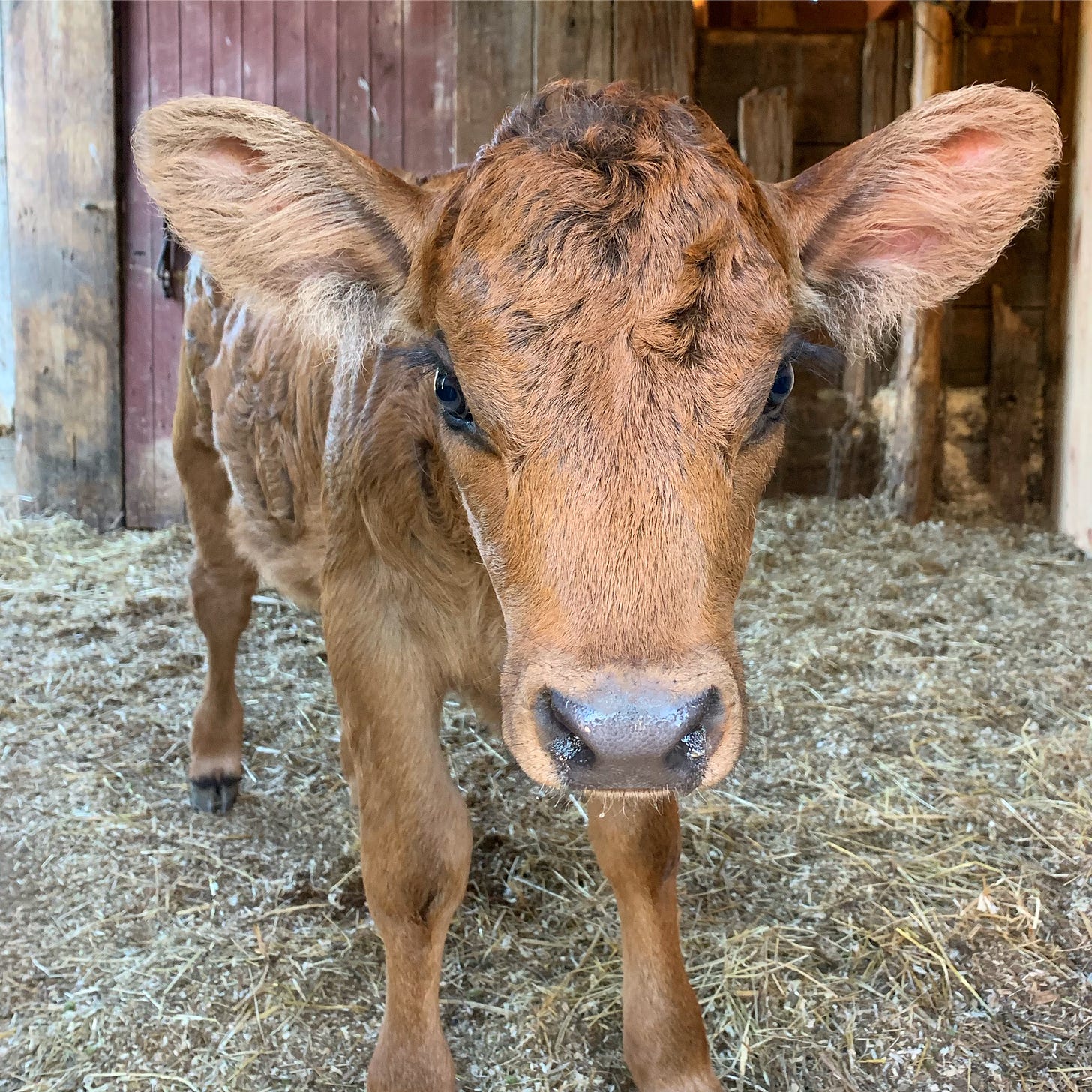

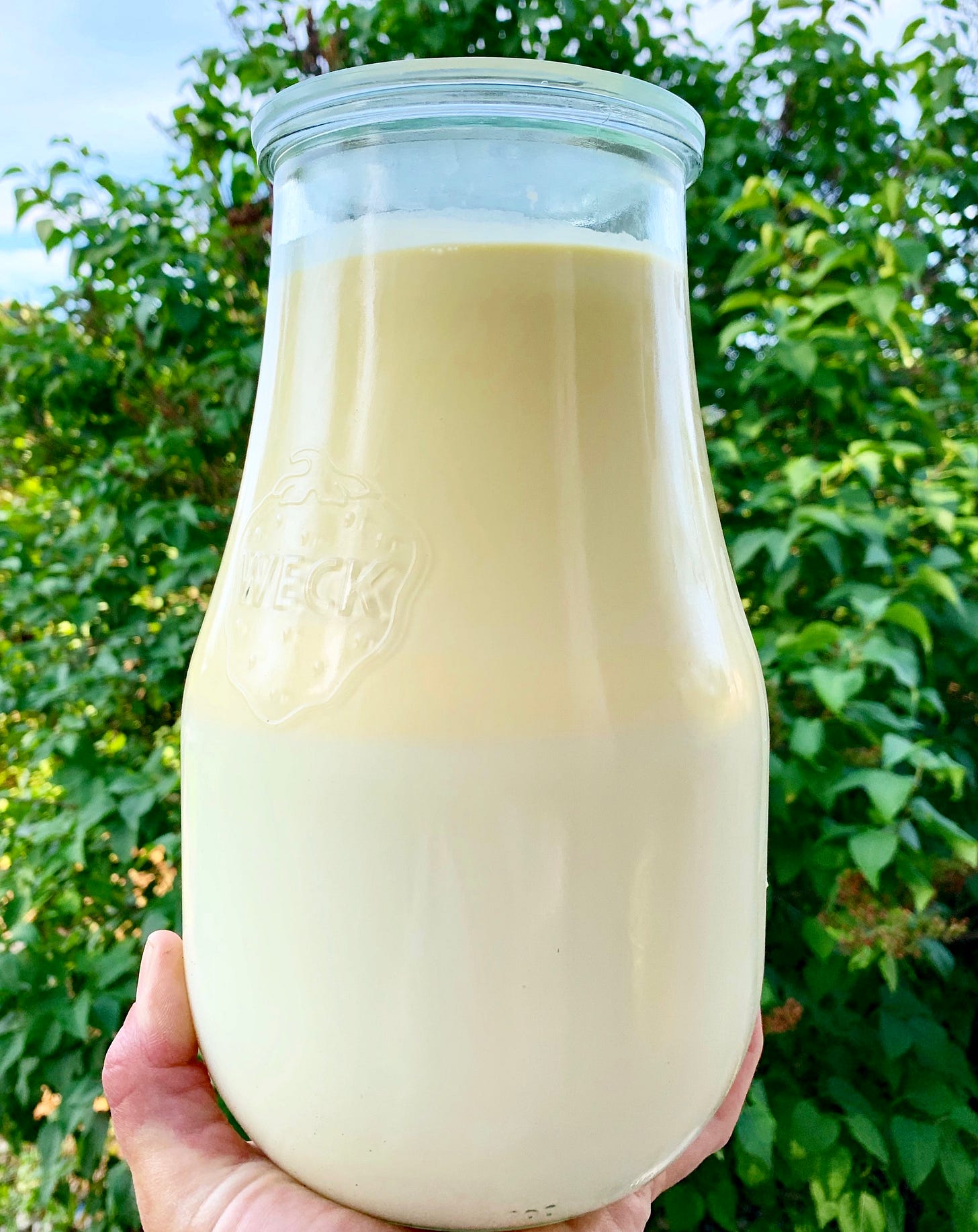
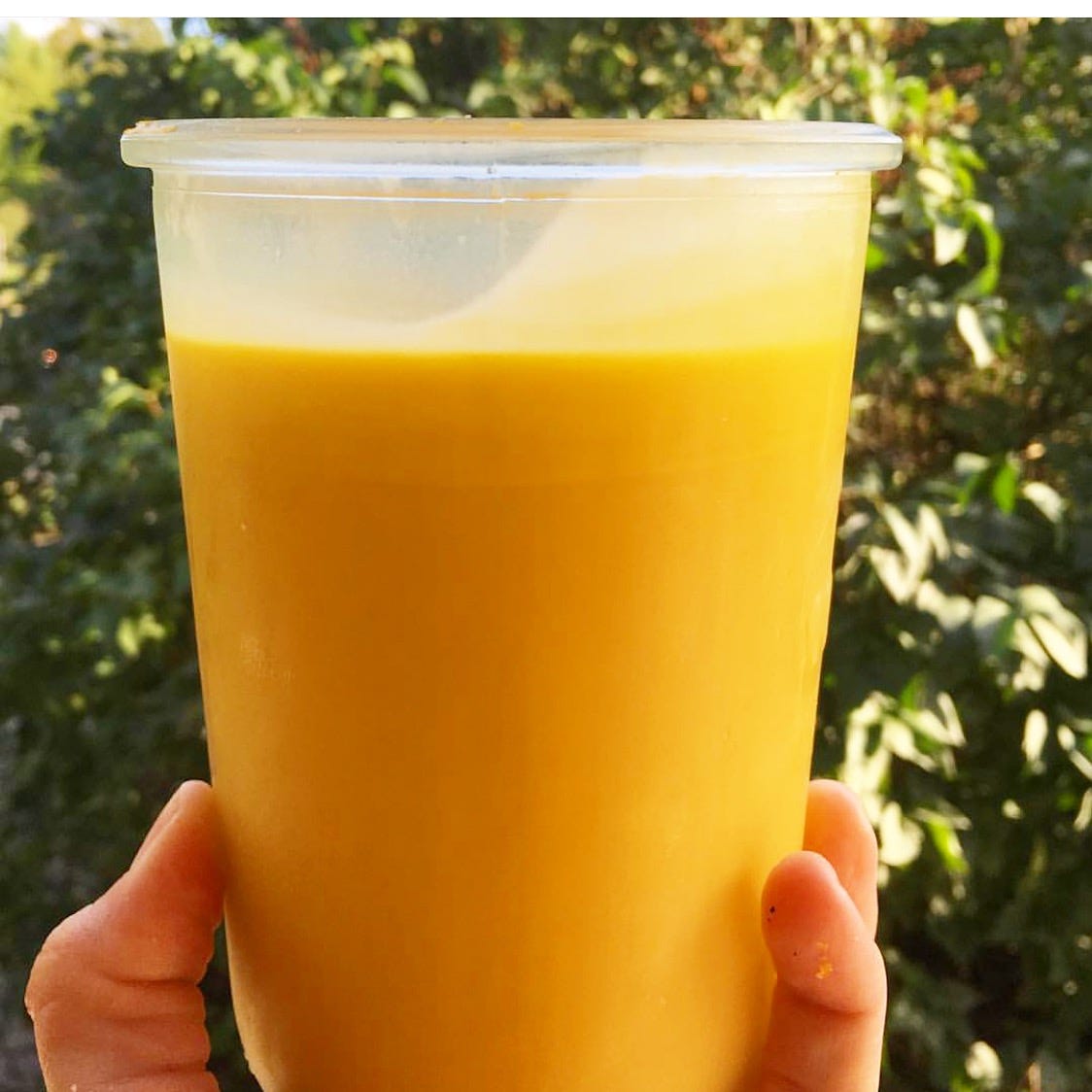
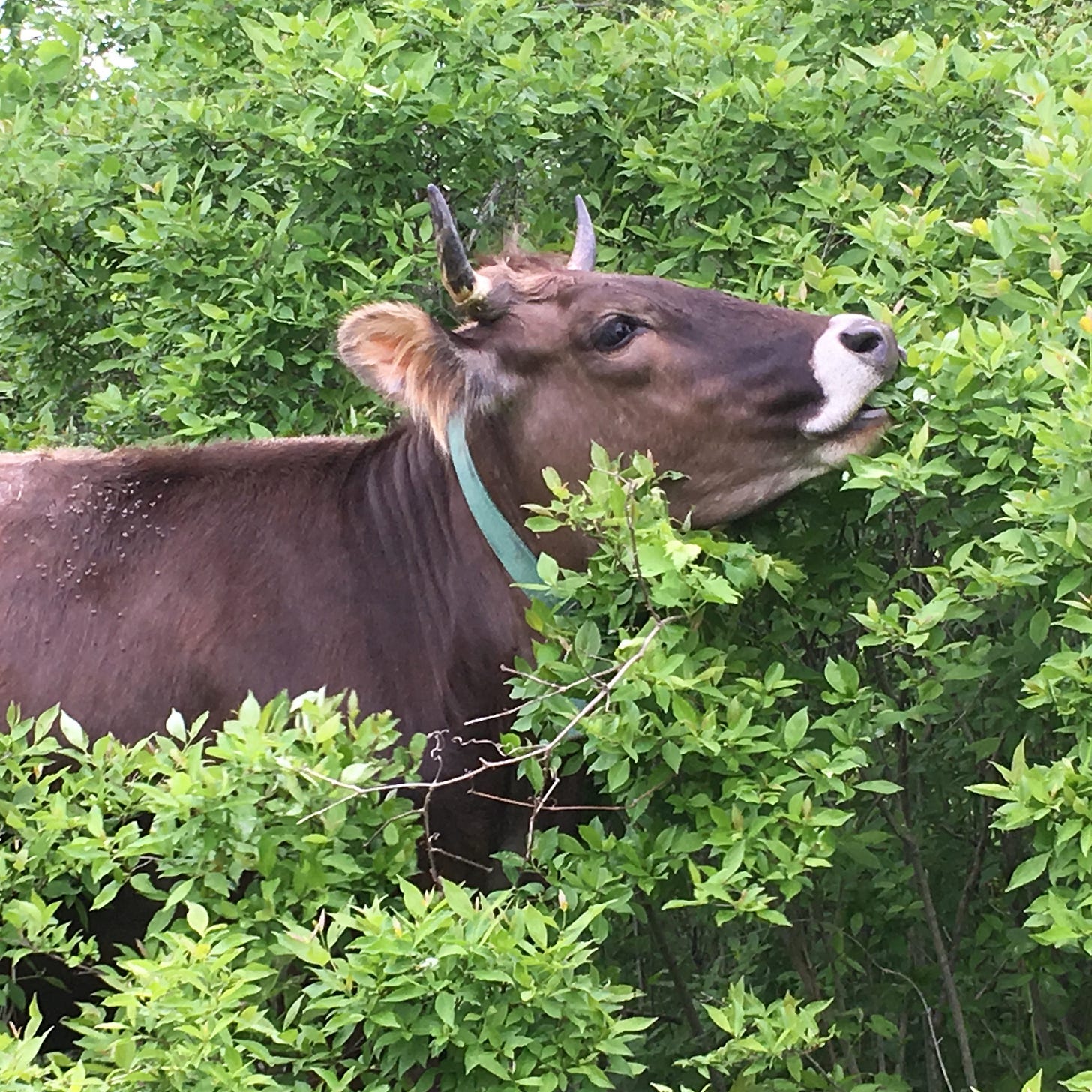
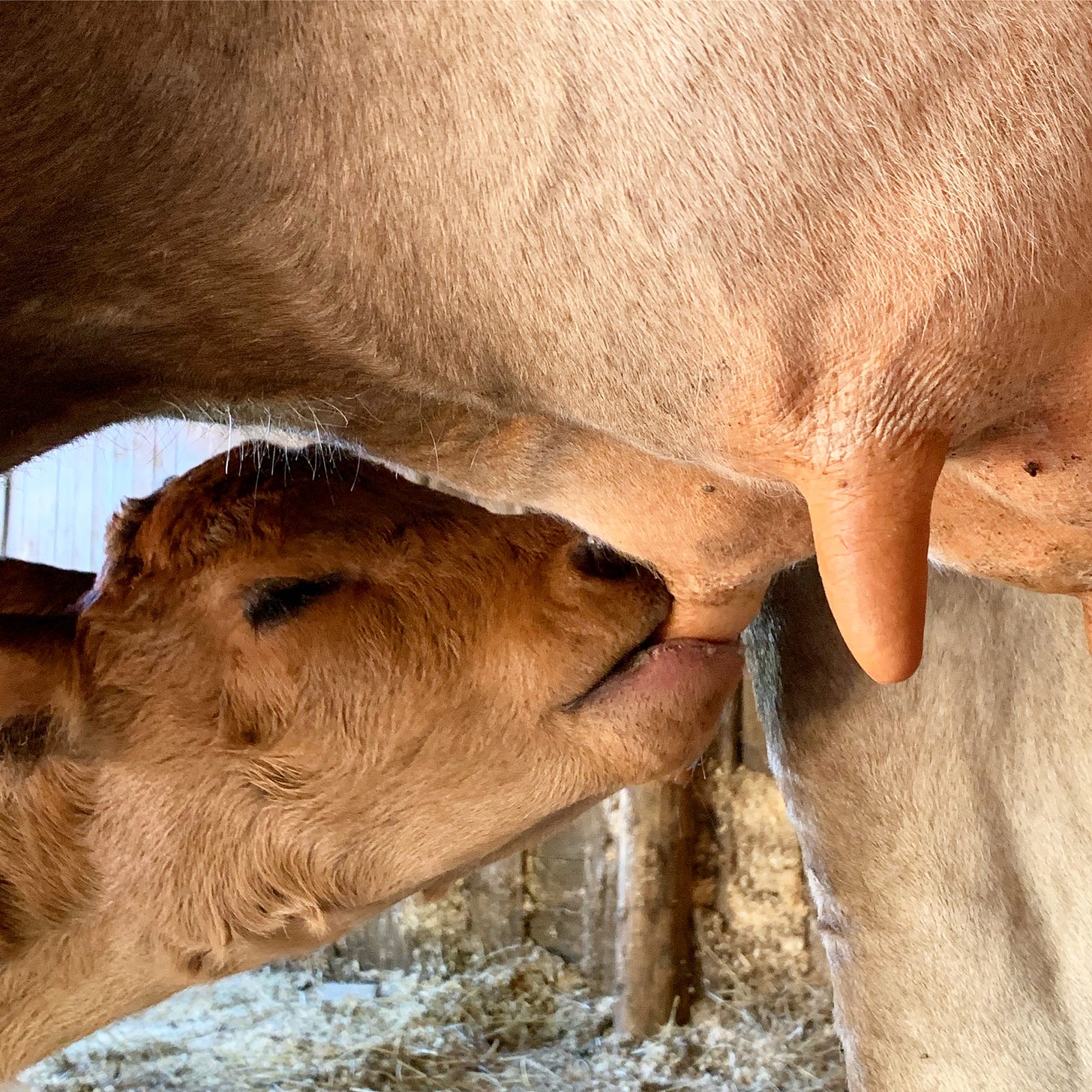
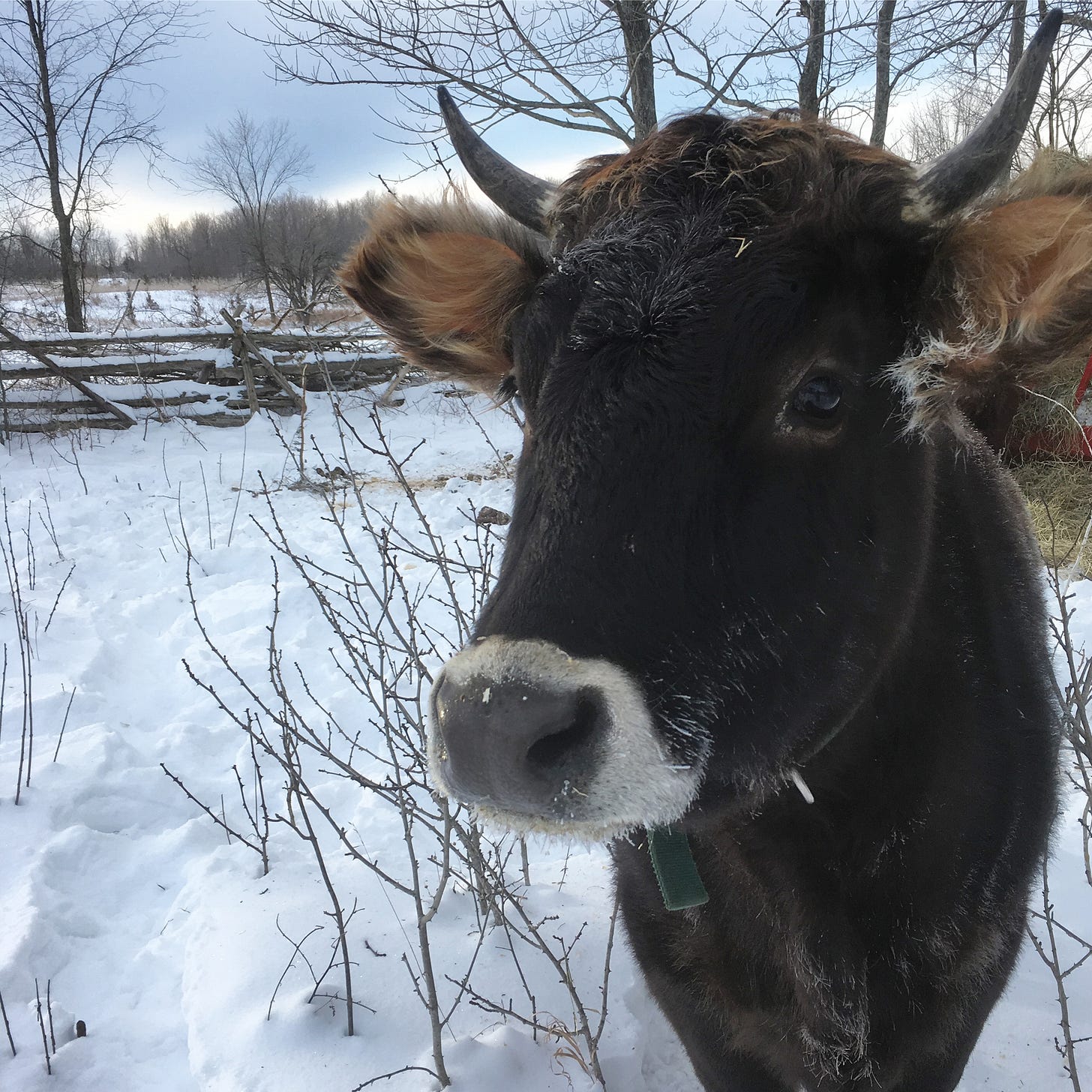
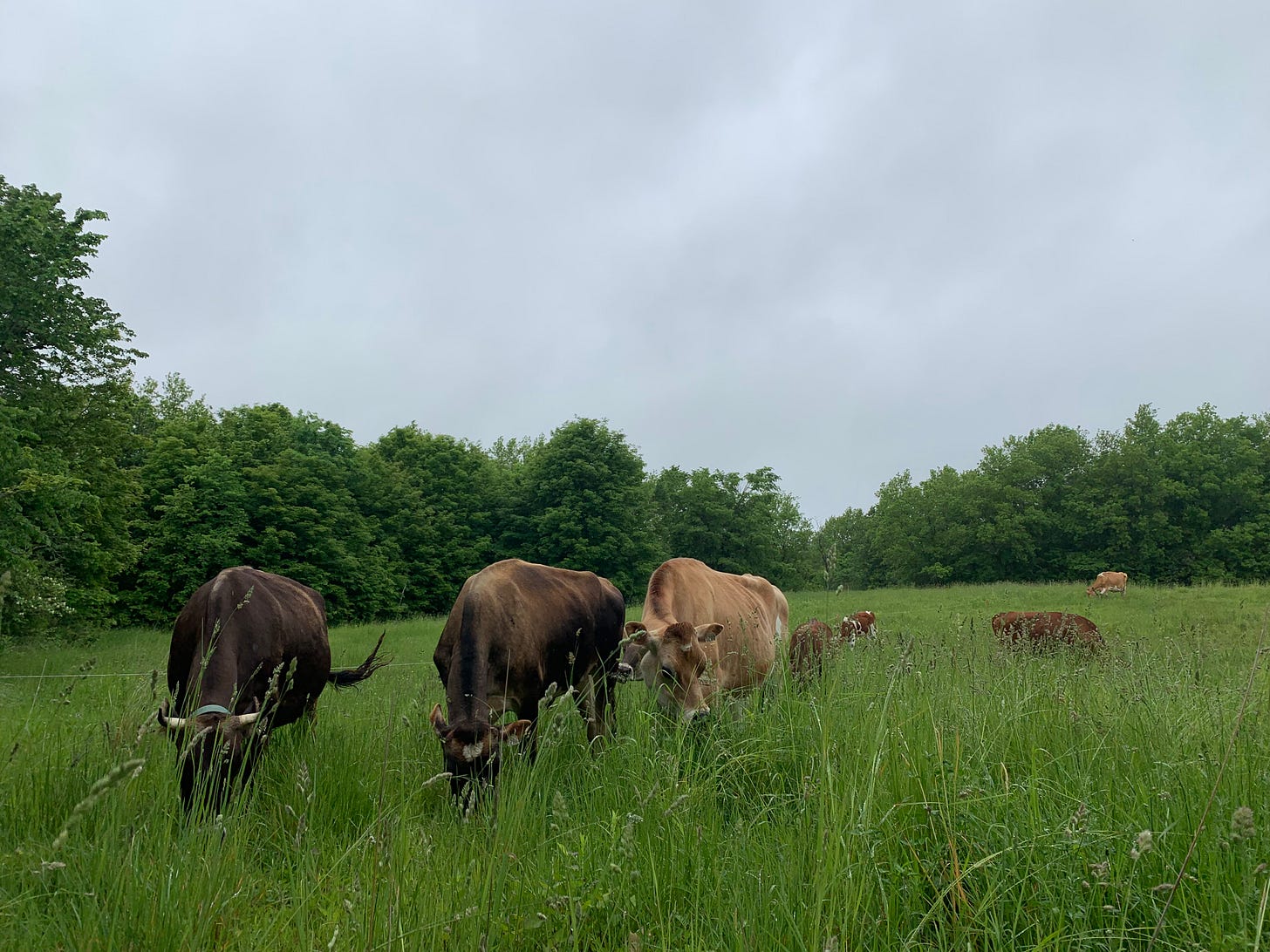
Share this post